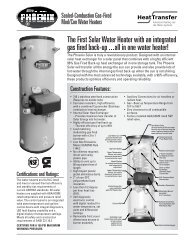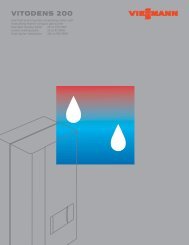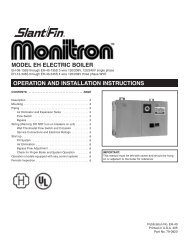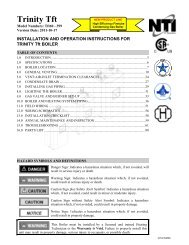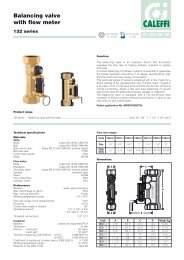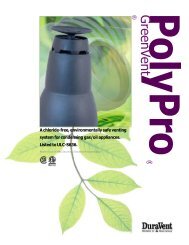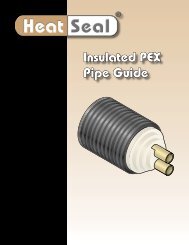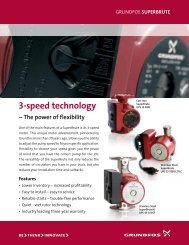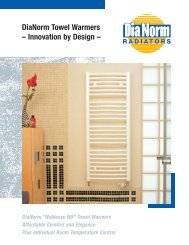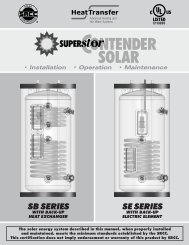Apricus Solar Water Heating System Installation and Operation ...
Apricus Solar Water Heating System Installation and Operation ...
Apricus Solar Water Heating System Installation and Operation ...
Create successful ePaper yourself
Turn your PDF publications into a flip-book with our unique Google optimized e-Paper software.
<strong>Apricus</strong> <strong>Solar</strong> Collector <strong>Installation</strong> & <strong>Operation</strong> Manual - USA- Roof flashing, if in direct contact with copper pipe- Soldering material must be rated to more than 480°F (250°C) within 24” linear from collector header- Washers or seals used in any quick-connect, compression or threaded fittings etc.- Heat transfer fluids<strong>Apricus</strong> solar collectors will not be damaged by thermal shock.b) High Temperature Controller Setting: Some controllers may have a high temperature setting which willprevent the pump from operating when the collector is above a certain limit. This function is mostcommonly used with drain-back systems as circulating water through the collector when hot would causelarge volumes of steam (depending on pressure setting) resulting in a pressure increases <strong>and</strong> potentialdumping of water/steam from the drain-back tank.c) Low Temperature Limits: The low temperature limits of all components in the system must be known<strong>and</strong> cannot be exceeded. In every climate region, all materials exposed to winter freezing conditions mustbe able to withst<strong>and</strong> such conditions. This is particularly important for any synthetic materials, such asplastics or rubbers that may become brittle when extremely cold. The following are examples ofcomponents that should be able to withst<strong>and</strong> the coldest conditions experienced in the installation location:- High-point ball valve (used for auto-air vent during system charging)- Pipe insulation (either high temp EPDM or fiberglass)- Roof flashing, if in direct contact with copper pipe- Washers or seals used in any quick-connect, compression or threaded fittings etc.- Heat transfer fluids, if closed loop- Rubber/plastic components on solar collectors, particularly if they are structural.<strong>Apricus</strong> uses silicone rubber components which are able to maintain good flexibility even during freezingconditions.d) Ultraviolet (UV) degradation: Any components installed outside must be able to withst<strong>and</strong> UV radiationwithout significant degradation. Color fading is common, but cracking, peeling <strong>and</strong> other severe degradationshould not occur during the design-life of any component in the system.e) Structural Loads: Components must be able to withst<strong>and</strong> environmental forces such as wind loading,snow loading, rain <strong>and</strong> hail. They must also be securely <strong>and</strong> positively fastened to the structure.- Wind loading refer to section 3.13.- Snow loading refer to section 3.14.- Hail refer to section 3.16.3.11. Fluid Expansiona) Thermal Expansion of <strong>Water</strong>: <strong>Water</strong> can exp<strong>and</strong> in volume by up to 2% from cold to hot in a solarthermal system. In the past, most water heaters utilized the cold supply inlet as a vessel to accept thisincrease in fluid volume; in other words, they literally pushed the excess volume backward against incomingwater pressure. Many codes now require back-flow prevention devices that prohibit this method. In thesecases, an expansion tank is necessary to accept increased fluid volume, otherwise the T/P Valve willdischarge frequently. If there is already an expansion tank present, you will need to install another one or alarger one, as necessary. For example, a direct flow system with an 80 gallon tank <strong>and</strong> 2 gallons in the solarloop needs between 1.5-2 Gallons of additional volume. The expansion tank needs to be able to accept thatamount of fluid. If no back-flow device is present, a potable expansion tank should not be necessary.b) Expansion Tank (potable AND direct flow): Direct flow systems AND closed systems that have a checkvalve or back-flow preventer on the incoming cold potable supply must have an expansion tank installed toaccept the potable water’s thermal expansion. The expansion tank must be potable water rated <strong>and</strong> sized toaccept the maximum thermal expansion possible for the entire volume of water heated in any <strong>and</strong> all thetanks in the system. Contact the expansion tank manufacturer to confirm, which model is necessary giventhe system fluid type, fluid volume, pressure <strong>and</strong> operating temperature range.c) Expansion Tank (closed loop): For closed loop systems, an appropriately-sized, expansion tank mustbe installed in the solar loop to accept the heat transfer fluid’s thermal expansion. The expansion tank mustCopyright 2011 – <strong>Apricus</strong> Inc Doc: A7-05.4.1.4-PB-1.9 Page 28 of 126



